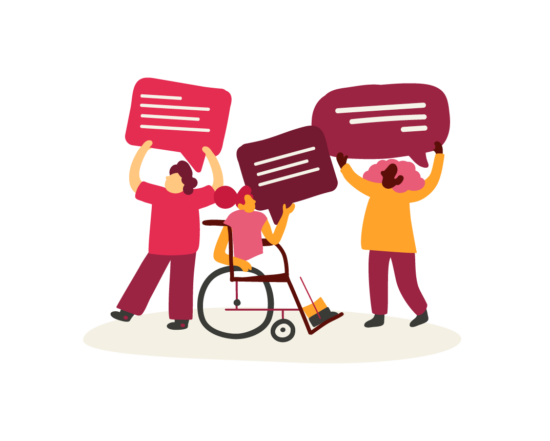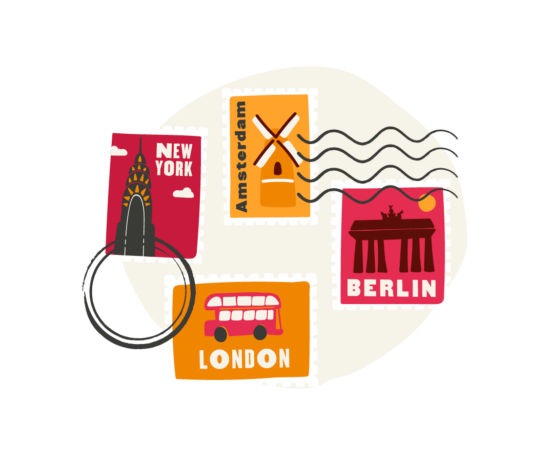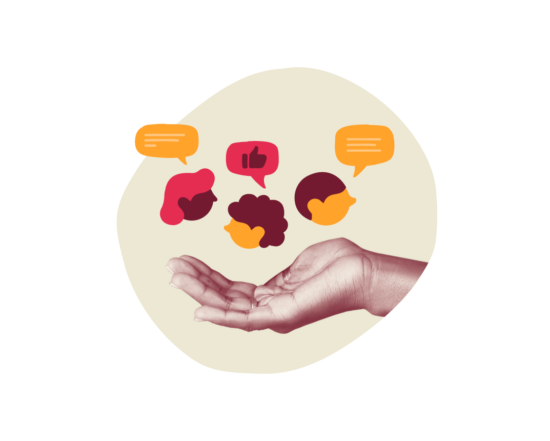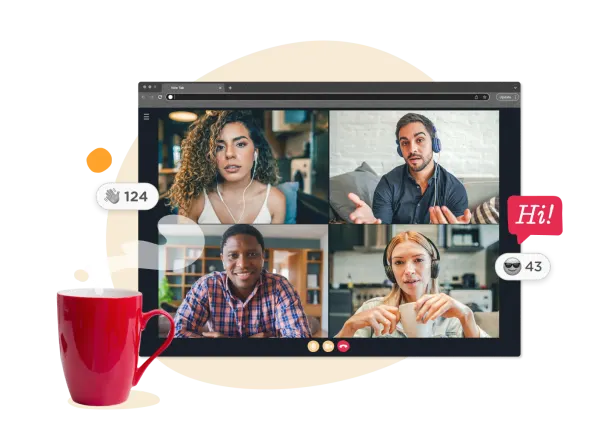In recent years, an inclusive and diverse workplace culture has rapidly made its way to the top of any HR leader’s priority list.
And for good reason. Not only do more diverse businesses tend to outperform others—diverse teams are better at making decisions 87 percent of the time—but they also have an advantage when it comes to attracting and retaining top talent. Roughly one in three job seekers today will simply not apply for a position at a company that lacks a strong DE&I culture.
In times of economic stress, laying the foundations for a healthier and more appealing culture can be the key to keeping your business lean and holding on to your most valuable assets—your people—as you weather the storm.
An effective DE&I plan creates an environment where everyone can feel valued and comfortable and perform at their best. In turn, that helps your business achieve its short- and long-term goals.
But what exactly can HR leaders do to foster a healthy and happy workplace culture that’s built around strong DE&I?

What is DE&I?
Diversity, equity, and inclusion in the workplace means recruiting, hiring, and retaining employees that are from different backgrounds, have different skills, and are treated as equally vital parts of the greater organization. This means that everyone feels truly welcome at your business, leading to teams that are reflective of the diversity of society at large.
Diversity is what makes individuals unique and goes beyond social categories such as gender, age, race, ethnicity, national origin, or marital status. While protecting and promoting the inclusion of employees from protected categories is vital to an organization’s culture, diversity should also include employees with a variety of skills, both hard and soft, viewpoints, education, experience, and expertise. It’s by embracing precisely this kind of diversity that you can build stronger teams who can generate more powerful ideas and operate more effectively.
What the law says about DE&I
In the United States, there are a number of laws that deal with workplace equality, including the Equal Pay Act of 1963 and Title VII of the Civil Rights Act of 1964.
More recently, regulations around DE&I fall under the Equal Employment Opportunity Commission (EEOC). This government agency creates and enforces laws protecting individual employees, mainly by specifying social categories that commonly face discrimination.
Organizations can include statements of commitment based on the EEOC’s categories; for example, the US government’s statement on equal employment defines discrimination on the basis of “race, color, religion, sex (including pregnancy and gender identity), national origin, political affiliation, sexual orientation, marital status, disability, genetic information, age, membership in an employee organization, retaliation, parental status, military service, or other non-merit factor.”
Of course, despite law and regulation, discrimination is still rampant in the workplace. According to recent studies, a remarkable 79.3 million US workers are affected by workplace bullying, harassment, or discrimination. With a resignation rate of 23 percent among victims, a culture that allows mistreatment can quickly be reflected in your turnover rate. Despite widespread efforts to combat this phenomenon, many companies are not succeeding in enforcing even the most basic anti-harassment standards, let alone fostering an organization-wide culture of DE&I.
Take, for example, recent research which found that most women—between 54 percent and 81 percent—have experienced some level of sexual harassment at work, but between 58 percent and 72 percent of victims don’t report those instances. Equally, racial discrimination at work remains a problem, even including exclusion from leadership opportunities and underrepresentation in high-status jobs.
Clearly, a shift is needed to empower victims to engage with HR. Too many companies are overlooking the pressing need to create a healthy and inclusive culture that supports their people.
Investing in building a diverse and inclusive workplace isn’t just right—it’s smart.
Why should an organization promote DE&I?
The moral reasons for fostering a healthy culture in the workplace and giving all employees equal opportunities are obvious. But if these weren’t convincing enough, research has shown that greater diversity also means greater profitability; diverse companies are twice as likely to meet or exceed their financial goals.
Diversity is also recognized as a driving force for innovation. When people with diverse backgrounds and skills collaborate in the workplace, the cross-pollination of different approaches often produces better results than an echo chamber.
Culture and diversity should go hand in hand. Providing an inclusive work environment for employees and enabling all individuals to bring their fullest selves to work every day will foster engagement and loyalty. This, in turn, will contribute to vastly improved retention and a happier, more productive workforce.
The younger generation is also demonstrating a far stronger commitment to diversity than previous ones. Research shows that 31 percent of people from Gen Z will actively seek employers who proactively promote diversity and inclusion in their workforce, compared to 11 percent of Gen X and 13 percent of Millennials.
If you want to attract and keep top talent, it’s important that you keep investing in culture and promoting DE&I.
The risks of ignoring culture are significant. Sometimes discrimination and discriminatory practices are subtle and might be written off as one-off incidents. But ignoring these will eventually poison an organization’s culture and potentially curb growth. A toxic workplace culture can cause plenty of damage, such as:
- Higher turnover
- Lower productivity
- Challenges recruiting talent
- Negative reputation
- Potential litigation and damages
- Higher personnel costs
So, how can HR help propel DE&I and foster a healthy workplace culture? It’s an ongoing process, but there are some ways to get started.

Creating culture at your organization
“Culture” describes the shared values, goals, attitudes, and practices that characterize an organization. This is about more than just hollow statements. It’s about the way people feel about the work they do, what they believe in, how they understand the company, and where they fit into the big picture.
It’s likely your organization already has a pervasive culture, whether this was intentional or not. And the current culture might not be built around DE&I. Rebuilding your organization’s culture won’t happen overnight—and it shouldn’t.
Creating culture is an ongoing process. Even if your organization has focused time and resources on DE&I policies, it is worth stepping back periodically to assess whether there are any gaps or concerns that need to be addressed. Here are five steps to check your culture and make it better:
- Identify your mission
Finding the cultural pillars of your organization means identifying the core values that inform company policies and operations. These unifying principles aren’t just about financial goals or disrupting industries. They’re about how your organization will make the world a little bit better, starting from within.
An important aspect of this articulates your organization’s commitment to DE&I and how this fits into the mission. Once you have identified your mission, get it down in writing and start incorporating it into your processes and organizational assets.
Examples of where to incorporate your organization’s mission are in the code of conduct, onboarding materials, the employee handbook, or DE&I training programs.
- Conduct a diversity audit
Find out how people feel about the organization and take a long hard look at your policies. One way to do this is to send out an anonymous questionnaire gauging culture and delivering insights to better understand what needs to be changed.
Also, ask whether your organization is truly diverse—including at the executive level. What proportion of your staff are people of color? Are women equally represented? What is your organization doing to actively empower employees from diverse backgrounds to bring their full selves to work every day? DE&I is about more than policy; it’s about actual representation.
For people with physical disabilities, inclusion entails implementing physical changes in the workplace to ensure adequate accommodation.
Of course, your recruitment and hiring processes should consider candidates irrespective of physical or psychological conditions. But in addition, it’s vital to build accessibility into the workplace. This includes making doors wide enough for wheelchairs or other devices, having elevators or ramps instead of just stairs, and building accessible bathrooms or eating areas.
With the dramatic uptake in remote work, it’s also important to build an accessible digital workspace for employees with diverse needs. For individuals with hearing or vision impairments, day-to-day operations will rely on the availability of assistive technologies like screen readers or transcription technology.
- Cascade the culture
Culture runs down from the top like a waterfall, so get your organization’s leaders, managers, and executives on board to ensure that culture informs day-to-day operations across departments.
This can involve implementing special diversity training for managers and supervisors or inviting leaders from across the organization to weigh in on culture. When frontline leaders are invested in culture, they will lead by example and will be more likely to make others feel welcome and included. In turn, those people will be more engaged and productive, and less likely to seek new employment.
Plus, when individual team members are intentionally included and made to feel valued, they also become better teammates themselves.
- Communicate, communicate, communicate
Keeping your people actively involved is integral to keeping your finger on the pulse of organizational culture. Create ample opportunities for people to express themselves and be sure to include them in decision-making processes. This may include town hall meetings, sensitivity training, anonymous online surveys, and other forums to keep your people aligned with the culture.
The best way to promote diversity is to consider diverse perspectives, so ask your people about what matters to them, how they feel day to day, and what they think could be improved. Team members that feel unheard will be less engaged—and less engaged means less productive and less loyal.
It’s also important that when implementing new policies, everyone gets the memo. Break down information silos and keep people aligned with transparency and open information. Using an online platform, especially with more and more companies adopting hybrid work, is crucial for an effective communication strategy.
- Seek out all kinds of diversity
As we’ve seen, bringing in people with diverse backgrounds and skill sets will enrich the work environment and encourage greater innovation. This isn’t just about special categories or checking boxes. It’s about enhancing productivity and improving culture by including a spectrum of outlooks, talents, and perspectives.
As the business world becomes increasingly global, for example, many companies are also turning to global workforces, which allow them to provide an “always-on” service to their customers. This kind of diversity, made possible by digital technology and flexible working arrangements, brings its own challenges but can supercharge your teams by widening your pool of potential recruits.
Not only is having a staff with diverse skills and backgrounds good for business, but it also contributes to a healthier culture. In this sense, while hitting targets is great, maintaining culture and promoting DE&I effectively relies on soft skills.

Soft skill development
Technical skills are an important part of a team member’s toolkit, but soft skills are equally—and sometimes more—important. An integral aspect of culture is prioritizing the promotion and development of soft skills from recruitment onward.
While many candidates will already have highly developed soft skills, these can also be honed. Like any ongoing professional training, soft skills should be taught and revisited at multiple junctures throughout their journey. Emphasizing soft skills demonstrates that there are more important things than the bottom line—namely, culture.
So what are some soft skills?
According to recent research, the most sought-after soft skills are communication skills, scheduling, time management, project management, analytical thinking, the ability to work independently, and flexibility. Good team members are more than just super-productive machines; they are also relationship builders, out-of-the-box thinkers, and problem-solvers.
Soft skills reduce performance gaps, enhance workplace relationships, and boost productivity. Helping your people improve throughout their tenure benefits everyone.
Protecting your culture from toxic influences
As much as soft skills contribute to better teams, toxic behaviors tear them apart. The old proverb about bad apples is pretty astute—toxicity can be contagious, so preventing it or curbing it before it affects your diversity and inclusivity culture development is vital.
Identifying toxic teammates
It’s important to train your managers and supervisors to keep an eye out for toxic behaviors and deal with them. Toxic teammates don’t go nuclear overnight—often, toxicity spreads slowly and subtly and may go unnoticed unless the culture is kept in check.
Sometimes colleagues approach HR or managers about toxic teammates, but that may be after the damage is already done. Identifying problematic behaviors early will ensure that toxicity is contained before it affects other people.
Some traits of toxic teammates are:
- Bossiness
- Passive aggression
- Unwillingness to accept responsibility
- Gossiping
- Insecurity
- Unwillingness to collaborate
- Competitiveness
- Resistance to being managed
- Argumentative
- Disengaged
How to deal with difficult or toxic employees
We can all agree that there should be zero tolerance for bullying, discrimination, or any form of violence in the workplace. But toxic behavior isn’t always blatant. Often it manifests subtly, becoming worse over time and dragging teams down.
The first question to ask is whether an underlying issue is causing this behavior. Is the person struggling with work or in their personal life? This could be the source of their toxic behavior. If this is the case, try to address the root cause and offer support.
Maybe the individual needs a more flexible schedule or would benefit from health services, so take the time to speak to them and hear them out. Make it clear that if they need assistance, it is available—but that they’ll have to take responsibility for their toxic behavior and do better.
Set clear expectations going forward, outline consequences, and check in frequently to improve things. Consider letting them work from home for a set period if they (and their teammates) need some space.
If things don’t get better, it may be necessary to take disciplinary action. Some people just can’t change, and wasting precious time and resources mitigating toxicity is bad for business. Keeping toxic teammates around can also spoil the culture for everyone.
Crucially, when dealing with a toxic employee, get everything in writing. Document any incidents—this will support the case for termination of employment if necessary.
The cost of perfectionists to their teams
All too often, perfectionism is overlooked as a toxic trait. While someone willing to work until everything is perfect may seem ideal, perfectionism is linked to higher levels of burnout, stress, workaholism, anxiety, and depression. And it doesn’t produce better results.
According to a meta-study of perfectionism in the workplace, performance and perfectionism were not related to each other—perfectionists are not better or worse performers than non-perfectionists. Instead, they are less likely to take risks out of fear of failure and may be indecisive or incapable of getting over past mistakes.
Perfectionists’ high expectations of themselves and others can also lead to hyper-criticism. At work, that can ruin team dynamics and negatively impact culture.
Like dealing with any other toxic teammate, sit down with the perfectionist and hear them out. Explain the harm of their behavior and clearly outline expectations. This isn’t just about stopping the behavior; it’s also about helping employees recognize the value of their work and the work of others.
Can perfectionists change their behavior?
If perfectionism can be harnessed, it can be beneficial for your organization. By setting reasonable expectations and keeping a watchful eye for signs of stress or burnout, managers and HR leaders can help a perfectionist understand that small mistakes aren’t the end of the world.
If someone’s perfectionism continues to affect their team, opening up lines of communication and implementing team-building training activities might solve the problem. If not, it might be necessary to part ways.

What is HR’s role in creating a culture of inclusion?
HR leaders are at the heart of creating workplace culture. From hiring to office parties, keeping an organization aligned and healthy depends on the policies, processes, and practices that you implement.
Here are some ways you can contribute:
- Establish regular monitoring of your progress with diversity and inclusion metrics that allow you to track, appraise, and adjust your strategy.
- Institute regular sensitivity training sessions. These shouldn’t only be company-wide—strengthen teams and empower managers with targeted training toward specific goals.
- Design DE&I-focused hiring policies. This includes using inclusive language when advertising job openings and ensuring that the hiring process accommodates all types of candidates.
- Hiring for a cultural fit doesn’t mean hiring people that are all the same. Instead, look to hire candidates that share a commitment to DE&I. Lots of different people can work together and build incredible things—but only if they respect each other.
- Beyond hiring for culture, onboarding for culture is another important way that HR can guide people. Develop processes that will get new hires on board with organizational goals and values and keep talking about them throughout the employee journey.
- Anti-discrimination policies articulate your organization’s commitment to DE&I. Making sure these are thoroughly drafted and clearly communicated is vital to creating and upholding culture, and HR can help get it done right.
- An open-door policy will give employees the opportunity to discuss any concerns they might have, including whether they have witnessed or experienced discrimination. Encourage your people to speak up so toxicity can be identified and remedied quickly.
- Offer opportunities for learning and growth around DE&I. This could include cultural days, events marking Pride Month, special speakers, or inclusion training.
- Create inclusive policies. From respecting religious diversity with flexible vacation policies to offering parental leave, having a little flexibility will go a long way toward showing that your organization respects its people’s needs.
Recommended For Further Reading
Create the culture; reap the rewards
A culture of diversity and inclusion at work not only improves the communication, teamwork, and productivity of your people but also boosts your recruitment and retention drives. In times of recession and economic difficulty, this has never been more important.
Ultimately, an inclusive culture makes your workplace environment better for everyone. It allows your people to feel able to express themselves and their ideas, and to openly and honestly work with their team members. That benefits them, and it benefits your organization.

How Bob supports your DE&I strategy
We know how important it is to make holistic and culturally sensitive decisions about your people, especially in light of today’s modern workplace trends. That’s why we built Bob, a people management platform that fosters an inclusive culture and boosts employee satisfaction by letting you collect and store relevant information on your people on one central platform.
Bob’s dashboards give you the tools you need to unpack insights into the prevalence of different groups across your organization, helping you plan your strategy based on hard evidence. Our brand-new DE&I dashboard gives you tailored insights relating to key DE&I metrics, and lets you analyze these alongside other data sets such as average salary, attrition rates, and promotion rates.
Use all of this people data to help you plan events, accommodations, and facilities, in addition to determining company policies and training. Put your people’s wellbeing first and boost employee satisfaction by being inclusive.
